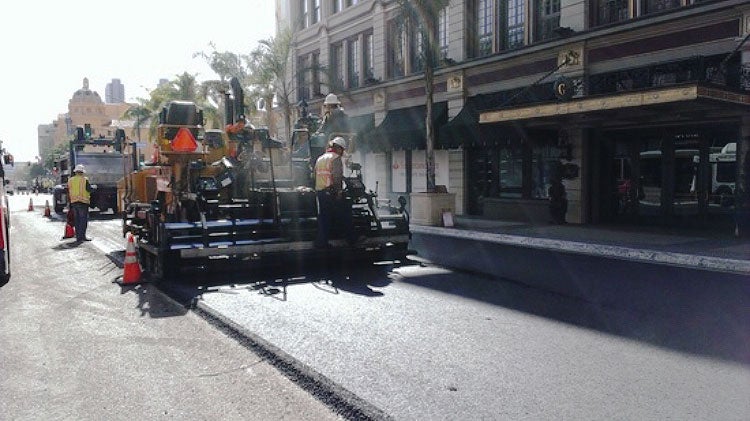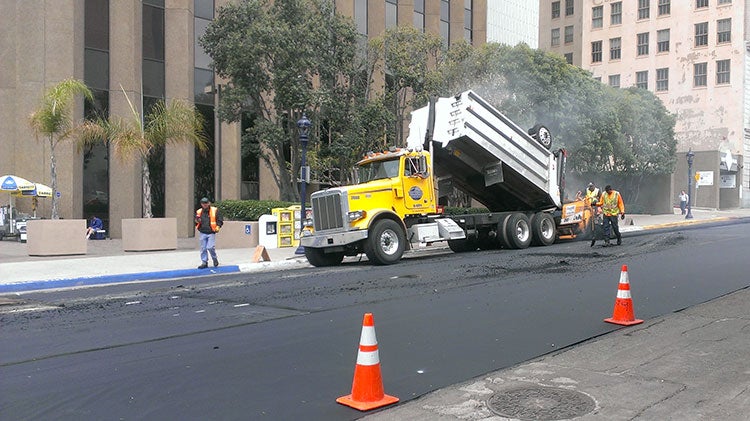City paving begins in Clairemont Mesa, Ocean Beach, Point Loma and Rancho Penasquitos
The city of San Diego assesses its extensive network of streets, totaling over 2,500 miles, every four years. A crew evaluates the pavement condition of each street, assigning a numerical score between 0 and 100, with higher scores indicating better conditions. The city uses these scores to prioritize repairs and maintenance, focusing on streets requiring more urgent attention.
Repair methods range from filling potholes to repaving or reconstructing entire street segments. The city also uses maintenance treatments, like slurry seal, to prevent potholes and preserve streets in good condition.
Several factors influence repair priority, including pavement condition, public repair requests, and traffic volumes. High-traffic streets deteriorate more quickly than residential streets, and street maintenance is part of a rotating cycle. City crews visit different council districts every business day, addressing service requests and looking for areas requiring repair. The public can submit requests via the city's Get-It-Done app, and the city considers various factors, such as upcoming utility work, to determine the best time for repairs.
A Street Repair Schedule is available on the city's website, allowing residents to see when work will be conducted in their communities. The city ensures all streets receive attention, although the frequency may vary. By proactively addressing street repairs, San Diego maintains its infrastructure and ensures a safer, smoother transportation network for its residents.
Street Resurfacing and Pothole Repair
sandiego.gov Street Division
Learn more about streets in your neighborhood and how the City maintains its network of 2,800 miles of streets.
What types of street repair exist?
Resurfacing
Asphalt Overlay
Asphalt overlay consists of installing a new layer of asphalt on top of the existing street surface at a thickness of one to three inches. Streets are ground down (milled) before resurfacing so asphalt will not build up at the edge of the gutter.
For more information on current asphalt overlay projects, visit the Capital Improvements Program Project Information page.


Slurry Seal
Slurry seal is a pavement preservation method consisting of asphalt emulsion, sand, and rock. This is applied to the street surface at an average thickness of ¼ of an inch. This cost-effective maintenance treatment extends the life of streets already in good condition. Slurry seal provides a durable surface and addresses existing surface distress on streets.

How is resurfacing scheduled?
A pavement management system, used to analyze data, helps determine when to schedule streets for resurfacing. Each street segment is assigned an "Overall Condition Index" (OCI) based on the pavement's roughness and cracks. To prioritize street paving, the OCI is used in conjunction with other factors, such as traffic volume, road type, maintenance history, other construction projects, and available funding. Repairs are often grouped within a neighborhood to include streets that are in similar condition or performed after other projects, such as pipeline replacement.
What if my street isn't on the list?
Reports of potholes are welcome, however there’s no need to report a street in need of resurfacing. Pavement surveys are conducted on a regular basis and this data is used to determine when streets will be repaired. Utilizing a street’s overall condition assessment, streets are planned for repaving work based on available funding and other factors such as traffic volume, road type, maintenance history, and other planned construction projects.
Pothole Repair
Potholes are small bowl-shaped depressions in the pavement surface. They generally have sharp edges and vertical sides near the top of the hole.
Potholes are created in many ways. The most common way is when water seeps into cracks in the surface of the road. Then, combined with the vibration of the tires over the cracks, this can cause the asphalt to fail. That is why there can be more potholes after it rains.
Vehicular traffic can cause the subsurface materials to move, generating a weak spot under the street. And every time that a vehicle travels over it, the damage grows until the new pothole is formed.
The City repairs more than 40,000 potholes per year using materials such as a hot patch compound and bagged asphalt.
Learn more
Report Other Issues
Published March 26, 2024 at 10:38 AM PDT
The project will involve the use of slurry seal "to prevent the deterioration of streets, which is vital to improving the overall condition of San Diego's network of roads," the city said in a news release Monday.
Officials added that slurry seal also reduces the need "for a more costly asphalt overlay and reconstruction for badly deteriorated streets."
According to the city, slurry seal is "a cost-effective pavement preservation method" made up of asphalt emulsion, sand and rock. Crews apply the mixture to street surfaces at an average quarter-inch thickness, extending the use of streets already in good condition.
The city uses a management system that helps it choose when to schedule projects, based on a condition index score based on the street's roughness and cracks.
Earlier this year, the city Transportation Department announced the results of a comprehensive survey of pavement conditions in San Diego.
To prioritize street paving, the city uses recent index scores along with other factors, including climate resiliency, equity, funding, mobility and road type.
The city often groups repairs within a neighborhood to include streets in similar conditions or undertake them after other projects, officials said.
A map of neighborhood street repairs is available at streets.sandiego.gov/.
Weather permitting, Slurry Seal Projects 2325 and 2326 will be finished through March and April. The following roads will be resurfaced:
- -Archer Street;
- -Fortuna Avenue;
- -Jewell Street;
- -Dawes Street;
- -Lamont Street;
- -Hiawatha Court;
- -Hiawatha Way;
- -Joplin Avenue;
- -Mabon Place;
- -Kamloop Avenue;
- -Jappa Avenue;
- -Galveston Street;
- -Littlefield Street;
- -Voltaire Street;
- -Udall Street;
- -Narragansett Avenue;
- -Guizot Street;
- -Orma Drive;
- -Temple Street;
- -Conde Street;
- -Conde Place;
- -Pine Street;
- -Ampudia Street;
- -Presidio Drive;
- -Arista Street;
- -Whitman Street;
- -Hortensia Street;
- -Arista Court;
- -Fort Stockton Drive;
- -Arista Drive;
- -Trias Street;
- -Crescent Drive;
- -Nashville Street;
- -Bervy Street;
- -Tonopah Avenue;
- -Frankfort Street;
- -Asher Street;
- -Lieta Street;
- -Camino Del Sur;
- -Butano Court;
- -Butano Way;
- -Sparren Way;
- -Camino Del Suelo;
- -Silver Ivy Lane;
- -Fallhaven Road;
- -Torrey Bella Court;
- -Torrey Glenn Road;
- -Watson Ranch Road;
- -Galway Place;
- -Waterford Lane;
- -Adobe Bluffs Drive;
- -Crimson Cedar;
- -Golden Elm Lane;
- -Gainsborough Avenue;
- -Clatsop Lane;
- -Clatsop Way;
- -Camino Del Suelo;
- -Gunnison Court;
- -Pipestone Way;
- -Alpine Ridge Road;
- -Orange Haven Place;
- -Hampe Court;
- -Rotherham Avenue;
- -Cayucos Court;
- -Cayucos Way;
- -Sparren Way;
- -Bodie Court;
- -Calle Tragar;
- -Bryn Glen Way;
- -Bryn Glen Court;
- -Crimson Cedar;
- -Golden Elm Lane;
- -Gunnison Court; and
- -Cherry Hill Drive.
Tags


Comments
Post a Comment